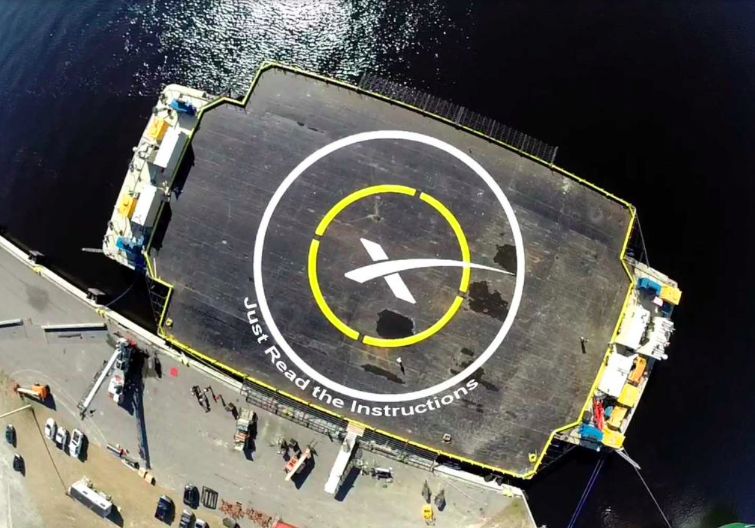
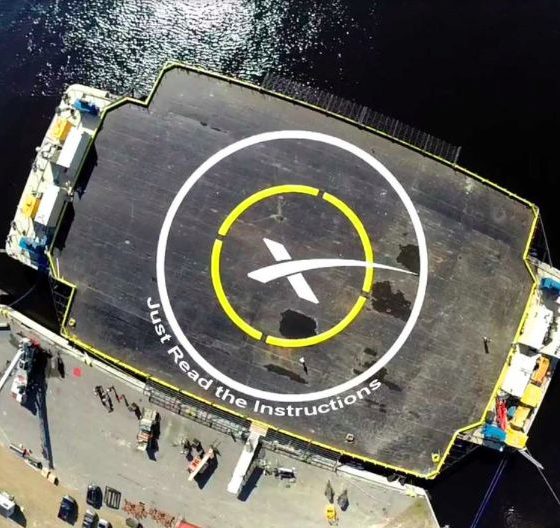
News
SpaceX to demonstrate weekly launch cadence: 3 launches in 14 days
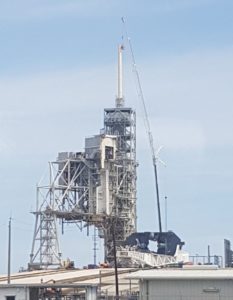
LC-39A undergoing repairs and tests after the launch of CRS-11. (/r/SpaceX)
SpaceX is in the process of preparing to launch BulgariaSat-1, with the first attempt scheduled for Saturday, June 17th between 2:10 p.m and 4:10 p.m. EST. BulgariaSat-1 will be Bulgaria’s second satellite ever and will act as a telecommunications hub in geostationary orbit, around 30,000 miles above Earth.
Following a highly successful launch and docking of the eleventh cargo mission of its Dragon spacecraft, Launch Complex 39A has since undergone routine checks to verify its condition and has likely been lightly repaired. The static fire for the upcoming mission is scheduled as early as tomorrow. Both the static fire and launch were pushed back two days due to a 48 hour delay of the CRS-11 launch.
The launch of BulgariaSat-1 is already exceptional for several reasons. First and foremost, the Falcon 9 first stage to be used in the upcoming mission has already flown once before, assisting in the successful launch of Iridium’s first ten NEXT satellites in early January of this year. It will thus mark the second time SpaceX has truly reused a Falcon 9 first stage. There has even been a bit of circumstantial evidence that the choice to launch on a recovered F9 resulted in BulgariaSat-1 being moved ahead of Intelsat 35e, which is now scheduled for no earlier than July 1st. Regardless, another successful reuse will be a boon for a SpaceX in the throes of an unprecedentedly busy year of launches by once again demonstrating the viability of their program of reuse and thus hopefully swaying more customers to take the leap to reused rocket cores.
The second reason, as touched on above, is that BulgariaSat-1 will mark the beginning of a two week period in which SpaceX could potentially conduct three separate launches, two at Cape Canaveral and one at Vandenberg Air Force Base. If successful, this would demonstrate weekly single-vehicle launch cadence, something that has not been seen in the launch industry in quite some time. This weekly cadence, if successful, will demonstrate a maturing company that is truly preparing for extraordinary launch cadence. By using two pads, one in California and one in Florida, SpaceX will still be able to provide two weeks between launches in order to prepare each launch site for the next launch, while effectively launching once a week. While Vandenberg Air Force Base can only support polar orbit launches, LC-40 is currently deep into the process of being repaired and reactivated following the failure of a Falcon 9 late last year.
With LC-40 preparing for reactivation sometime in August or September, SpaceX will find themselves at long last with two viable all-purpose launch pads in very close proximity to each other. By staggering launches on each pad and continuing to maintain the two week pad turnaround time after launches, SpaceX could theoretically begin to sustain regular weekly launches as few as three months from now. A successful weekly cadence this month could reinforce that such a sequence of events is a possibility.
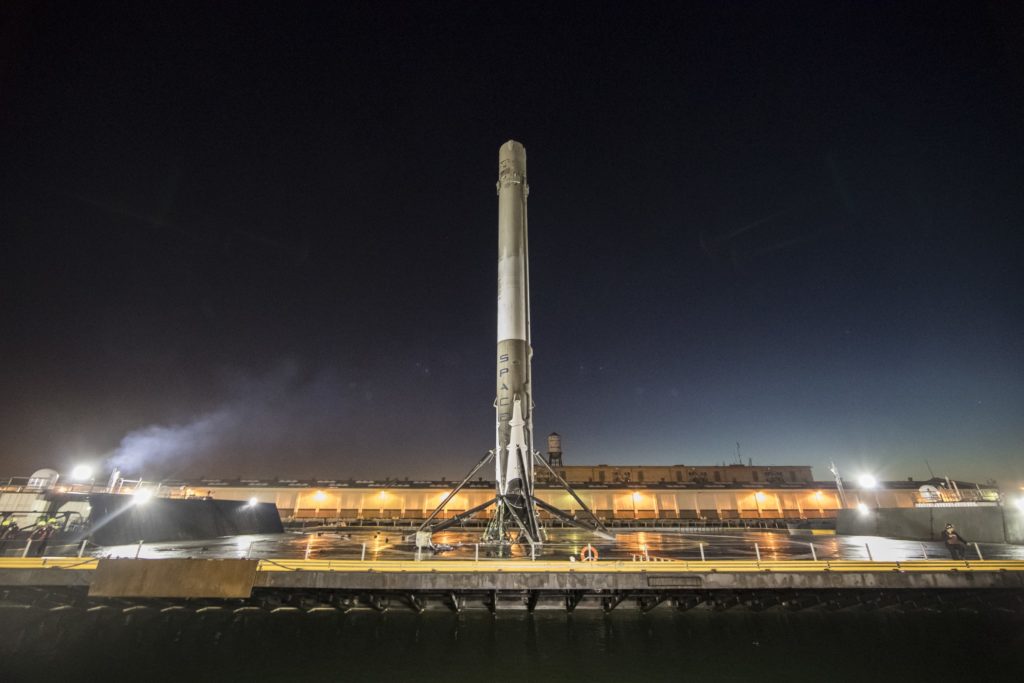
Iridium NEXT 1’s Falcon 9 first stage after recovery in the Pacific Ocean. (SpaceX)
SpaceX has long been working to rapidly increase its ability to launch frequently, and this year has been an exceptional example of several pieces fitting together. The company has begun to use an automated flight termination system, which will allow them to rely less upon the availability of Cape Canaveral’s Range Officers while crafting their manifest and launch schedules. Normally, the flight termination system in rockets is monitored by an actual team of people who have barely a few seconds to decide if rocket telemetry is less than nominal and prevent what is effectively a large missile from impacting populated areas. SpaceX has replaced this with an arguably much safer approach dependent upon their mature autonomous avionics systems, simply meaning that computers on board their rockets and spacecraft automatically analyze telemetry and control vehicle performance and guidance. SpaceX has been testing this system in a way that is almost identical to Tesla’s method of installing inert autonomy software that can learn without actually controlling the vehicle, and it is consequently only now being implemented after SpaceX and the Air Force have a high degree of confidence that it will outperform its human colleagues.
The ultimate goal of this automated flight termination system (AFTS), as well as many other significant changes to both the hardware of pads and vehicles, is to eventually allow SpaceX to accomplish Elon Musk’s long fabled and oft-ridiculed goal of 24-hour reusability, and thus 24-hour launch cadence. SpaceX and the USAF have both stated that AFTS alone will likely allow Cape Canaveral to support up to 48 launches a year. While shared between ULA and SpaceX, even 36 launches a year would effectively leave SpaceX with a shrinking launch manifest and significantly increased revenue and profit. This would speculatively allow them to more rapidly develop their pursuits of Mars, a vast constellation of broadband satellites, and more.
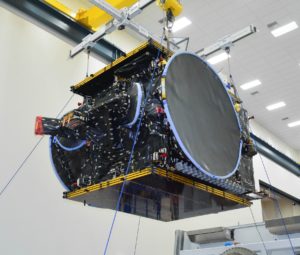
BulgariaSat-1 being prepared for launch. (SSL)
Nevertheless, this is all of course speculation and dependent upon many things going well. If SpaceX is able to successfully launch BulgariaSat-1 on June 17th, Iridium NEXT 2 on the 25th, and Intelsat 35e on July 1st, they will have successfully demonstrated the ability to support a weekly launch cadence and will have to do little more than wait for the availability of a second East coast pad to begin to take full advantage of it.
With ten launches scheduled between now and October and ten more launches scheduled between October and the end of December, it is guaranteed to be one incredible year for SpaceX and their fans.

Cybertruck
Tesla updates Cybertruck owners about key Powershare feature

Tesla is updating Cybertruck owners on its timeline of a massive feature that has yet to ship: Powershare with Powerwall.
Powershare is a bidirectional charging feature exclusive to Cybertruck, which allows the vehicle’s battery to act as a portable power source for homes, appliances, tools, other EVs, and more. It was announced in late 2023 as part of Tesla’s push into vehicle-to-everything energy sharing, and acting as a giant portable charger is the main advantage, as it can provide backup power during outages.
Cybertruck’s Powershare system supports both vehicle-to-load (V2L) and vehicle-to-home (V2H), making it flexible and well-rounded for a variety of applications.
However, even though the feature was promised with Cybertruck, it has yet to be shipped to vehicles. Tesla communicated with owners through email recently regarding Powershare with Powerwall, which essentially has the pickup act as an extended battery.
Powerwall discharge would be prioritized before tapping into the truck’s larger pack.
However, Tesla is still working on getting the feature out to owners, an email said:
“We’re writing to let you know that the Powershare with Powerwall feature is still in development and is now scheduled for release in mid-2026.
This new release date gives us additional time to design and test this feature, ensuring its ability to communicate and optimize energy sharing between your vehicle and many configurations and generations of Powerwall. We are also using this time to develop additional Powershare features that will help us continue to accelerate the world’s transition to sustainable energy.”
Owners have expressed some real disappointment in Tesla’s continuous delays in releasing the feature, as it was expected to be released by late 2024, but now has been pushed back several times to mid-2026, according to the email.
Foundation Series Cybertruck buyers paid extra, expecting the feature to be rolled out with their vehicle upon pickup.
Cybertruck’s Lead Engineer, Wes Morrill, even commented on the holdup:
As a Cybertruck owner who also has Powerwall, I empathize with the disappointed comments.
To their credit, the team has delivered powershare functionality to Cybertruck customers who otherwise have no backup with development of the powershare gateway. As well as those with solar…
— Wes (@wmorrill3) December 12, 2025
He said that “it turned out to be much harder than anticipated to make powershare work seamlessly with existing Powerwalls through existing wall connectors. Two grid-forming devices need to negotiate who will form and who will follow, depending on the state of charge of each, and they need to do this without a network and through multiple generations of hardware, and test and validate this process through rigorous certifications to ensure grid safety.”
It’s nice to see the transparency, but it is justified for some Cybertruck owners to feel like they’ve been bait-and-switched.
News
Tesla’s northernmost Supercharger in North America opens

Tesla has opened its northernmost Supercharger in Fairbanks, Alaska, with eight V4 stalls located in one of the most frigid cities in the U.S.
Located just 196 miles from the Arctic Circle, Fairbanks’s average temperature for the week was around -12 degrees Fahrenheit. However, there are plenty of Tesla owners in Alaska who have been waiting for more charging options out in public.
There are only 36 total Supercharger stalls in Alaska, despite being the largest state in the U.S.
Eight Superchargers were added to Fairbanks, which will eventually be a 48-stall station. Tesla announced its activation today:
North America’s northernmost Supercharger Fairbanks, AK (8 stalls) opened to public. https://t.co/M4l04DZ6B5 pic.twitter.com/zyL6bDuA93
— Tesla Charging (@TeslaCharging) December 12, 2025
The base price per kWh is $0.43 at the Fairbanks Supercharger. Thanks to its V4 capabilities, it can charge at speeds up to 325 kW.
Despite being the northernmost Supercharger in North America, it is not even in the Top 5 northernmost Superchargers globally, because Alaska is south of Norway. The northernmost Supercharger is in Honningsvåg, Norway. All of the Top 5 are in the Scandanavian country.
Tesla’s Supercharger expansion in 2025 has been impressive, and although it experienced some early-quarter slowdowns due to V3-to-V4 hardware transitions, it has been the company’s strongest year for deployments.
🚨🚨 Tesla Supercharging had a HUGE year, and they deserve to be recognized.
🍔 Opened Tesla Diner, a drive-in movie theater with awesome, Chef-curated cuisine
🔌 Gave access to Superchargers to several EV makers, including Hyundai, Genesis, Mercedes-Benz, Kia, Lucid, Toyota,… pic.twitter.com/yYT2QEbqoW
— TESLARATI (@Teslarati) December 10, 2025
Through the three quarters of 2025, the company has added 7,753 stations and 73,817 stalls across the world, a 16 percent increase in stations and an 18 percent increase in stalls compared to last year.
Tesla is on track to add over 12,000 stalls for the full year, achieving an average of one new stall every hour, an impressive statistic.
Recently, the company wrapped up construction at its Supercharger Oasis in Lost Hills, California, a 168-stall Supercharger that Tesla Solar Panels completely power. It is the largest Supercharger in the world.
News
Tesla shocks with latest Robotaxi testing move
Why Tesla has chosen to use a couple of Model S units must have a reason; the company is calculated in its engineering and data collection efforts, so this is definitely more than “we just felt like giving our drivers a change of scenery.”

Tesla Model S vehicles were spotted performing validation testing with LiDAR rigs in California today, a pretty big switch-up compared to what we are used to seeing on the roads.
Tesla utilizes the Model Y crossover for its Robotaxi fleet. It is adequately sized, the most popular vehicle in its lineup, and is suitable for a wide variety of applications. It provides enough luxury for a single rider, but enough room for several passengers, if needed.
However, the testing has seemingly expanded to one of Tesla’s premium flagship offerings, as the Model S was spotted with the validation equipment that is seen entirely with Model Y vehicles. We have written several articles on Robotaxi testing mules being spotted across the United States, but this is a first:
🚨 Tesla is using Model S vehicles fitted with LiDAR rigs to validate FSD and Robotaxi, differing from the Model Ys that it uses typically
Those Model Y vehicles have been on the East Coast for some time. These Model S cars were spotted in California https://t.co/CN9Bw5Wma8 pic.twitter.com/UE55hx5mdd
— TESLARATI (@Teslarati) December 11, 2025
Why Tesla has chosen to use a couple of Model S units must have a reason; the company is calculated in its engineering and data collection efforts, so this is definitely more than “we just felt like giving our drivers a change of scenery.”
It seems to hint that Tesla could add a premium, more luxury offering to its Robotaxi platform eventually. Think about it: Uber has Uber Black, Lyft has Lyft Black. These vehicles and services are associated with a more premium cost as they combine luxury models with more catered transportation options.
Tesla could be testing the waters here, and it could be thinking of adding the Model S to its fleet of ride-hailing vehicles.
Reluctant to remove the Model S from its production plans completely despite its low volume contributions to the overall mission of transitioning the world to sustainable energy, the flagship sedan has always meant something. CEO Elon Musk referred to it, along with its sibling Model X, as continuing on production lines due to “sentimental reasons.”
However, its purpose might have been expanded to justify keeping it around, and why not? It is a cozy, premium offering, and it would be great for those who want a little more luxury and are willing to pay a few extra dollars.
Of course, none of this is even close to confirmed. However, it is reasonable to speculate that the Model S could be a potential addition to the Robotaxi fleet. It’s capable of all the same things the Model Y is, but with more luxuriousness, and it could be the perfect addition to the futuristic fleet.








